Mailchimp vs MailerLite: A complete comparison
If you’re trying to choose between Mailchimp vs MailerLite for your email marketing needs, our honest comparison is here to help.
We’re not going to pick a single “winner” in this post. Instead, we’re just going to highlight the similarities and differences between Mailchimp and MailerLite features, interfaces, pricing, and other key areas.
Our goal is that you can use this information to make the right choice for your specific situation.
If you’re looking for an email marketing tool for your WordPress website, we’ll also cover how these two services can integrate with WordPress and Gravity Forms to let you create email opt-in forms on your site.
Let’s get into it!
Key features
To start off our comparison, let’s look at some of the main features that you get access to with Mailchimp and MailerLite.
Both services can handle all of the essentials of email marketing, including managing contacts and dividing them into segments, designing emails, setting up automations, and lots more.
Both also offer some other value-added features that you might be interested in, including transactional email sending, SMS messages, website builders, and more.
Mailchimp email marketing features
- List management tools and segmentation – Use audiences to organize your contacts and then apply tags to create more targeted segments as needed.
- Drag-and-drop email builder – You get code-free tools to design custom email templates (or you can always work directly with HTML).
- 200+ email templates – Choose from 200+, pre-made email templates to help you save time.
- Detailed segmentation – Access a bunch of different options to create targeted segments. For ecommerce stores, you can also use ecommerce activity/data to create your segments.
- Visual automation builder – Set up all different kinds of automations using a visual builder and 50+ supported triggers.
- Detailed analytics – Visualize the data around your email marketing efforts including click/open rates, demographic details, ecommerce metrics, and more.
- Ecommerce integrations – Mailchimp integrates with WooCommerce, Shopify, and other popular ecommerce platforms.
- A/B testing tools – Test a variety of different scenarios including subject lines, content, and even email send times.
- AI content creation tools – Access AI text and image generation from inside Mailchimp.
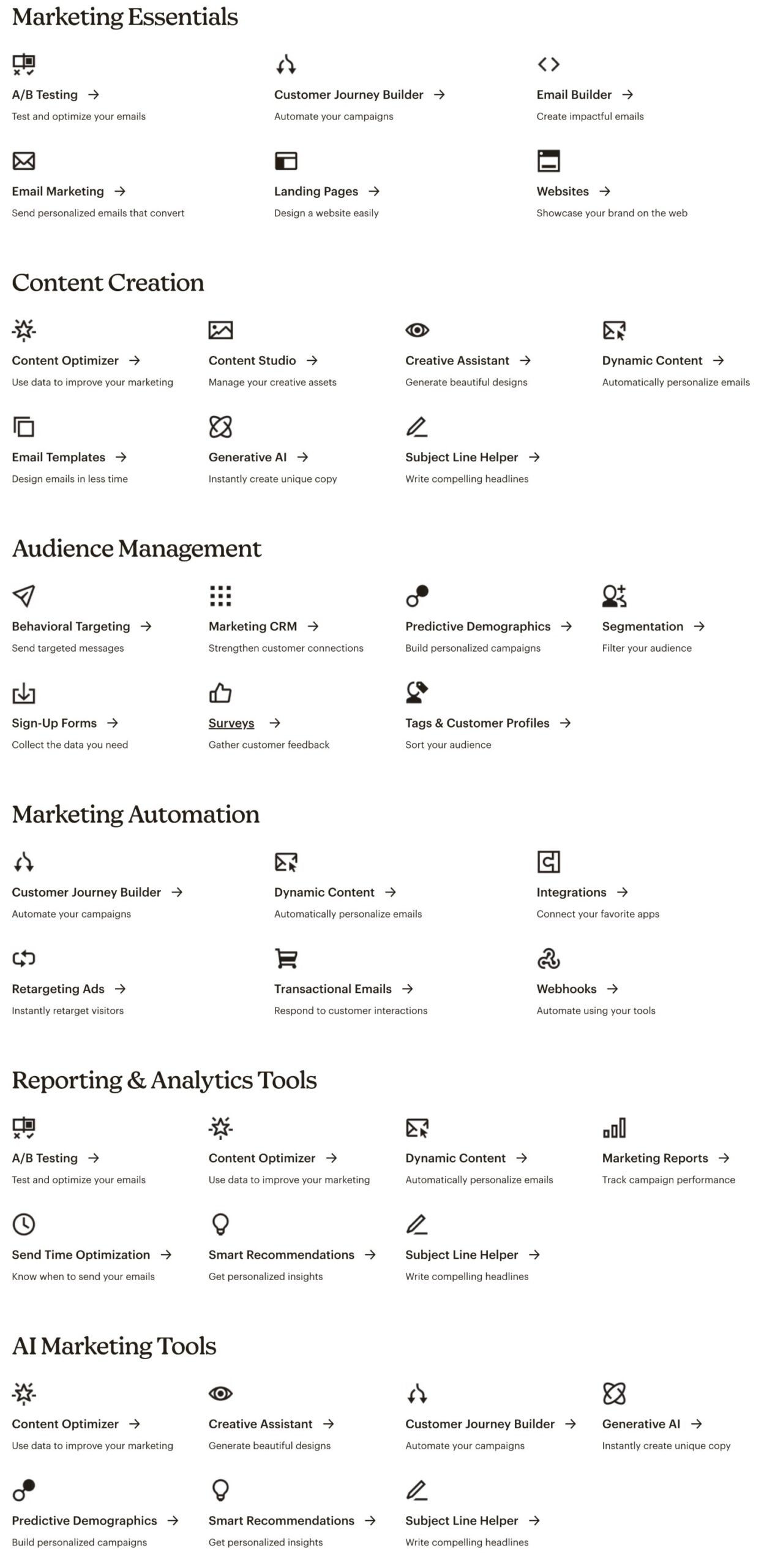
Mailchimp Transactional Email
In addition to letting you send marketing emails, Mailchimp also offers a transactional email service called Mailchimp Transactional (formerly Mandrill).
If you combine Mailchimp Transactional with a WordPress SMTP plugin like Gravity SMTP, you can use Mailchimp to send all of your WordPress site’s transactional emails alongside your marketing emails. Gravity SMTP lets you connect directly to Mailchimp Transactional using its API.
Other features in Mailchimp
Beyond its email-related features, Mailchimp also has some other functionality that you might find useful:
- SMS marketing – You also have the option to send contacts SMS/text messages. Mailchimp’s SMS marketing works in 12+ different countries including the USA and Canada, as well as a number of European countries and Australia.
- Lightweight customer relationship manager (CRM) – Mailchimp offers CRM functionality that can handle basic CRM needs.
- Social media marketing/content creation – You can easily create and manage posts for all of your social media accounts, including tools to adjust an image for different formats.
- Social media advertising – In addition to creating social media content, Mailchimp can also help you run ads on social media, including support for Facebook and Instagram ads.
- Website builder – You can create entire websites or just standalone landing pages. While WordPress will still give you a lot more flexibility, this can work fine for simple use cases.
Integrations in Mailchimp
Currently, Mailchimp offers 300+ integrations for a variety of different services. There’s also a convenient directory that lets you browse all of these integrations even if you haven’t signed up for Mailchimp yet – check it out here.
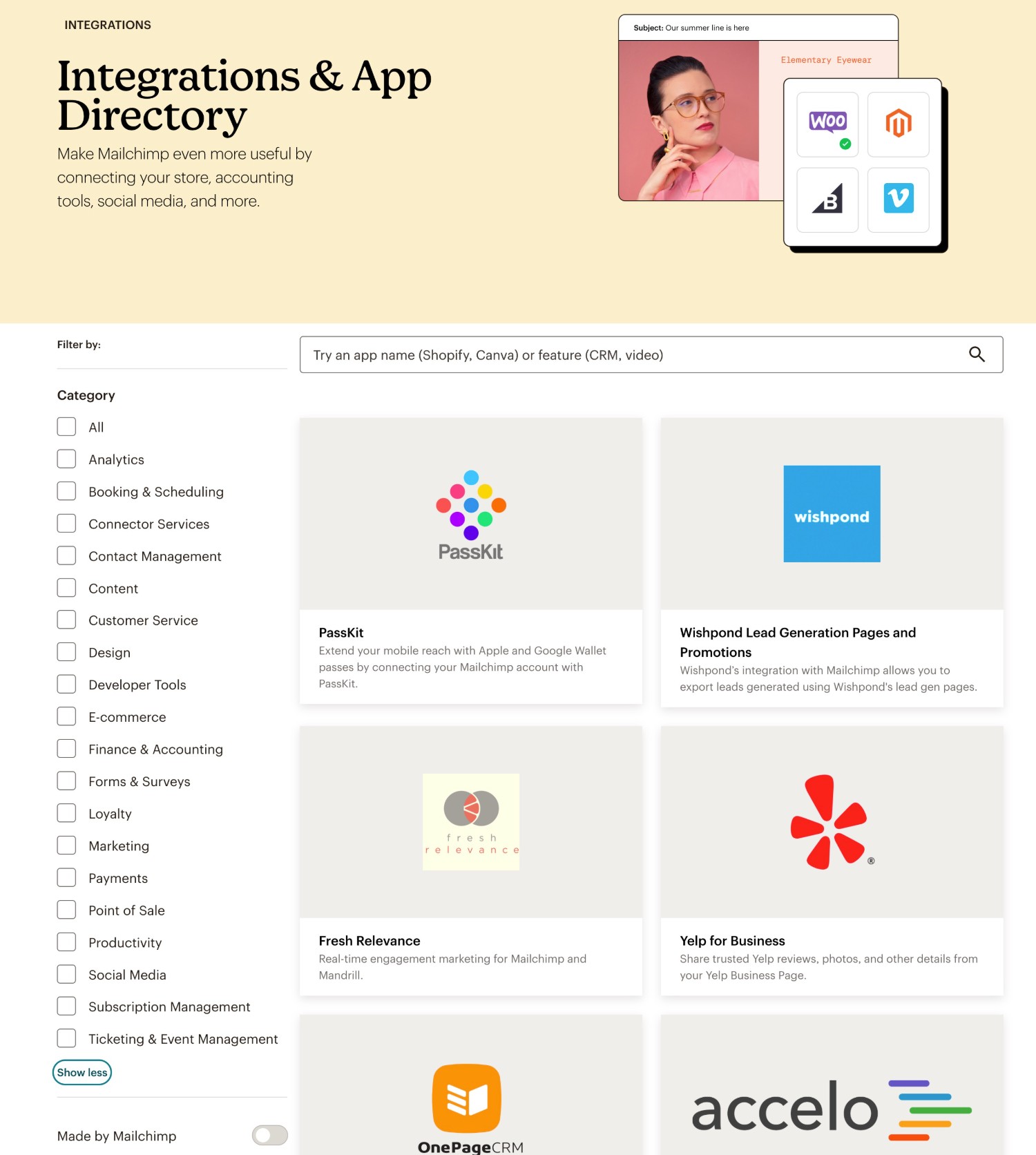
If you’re using WordPress and Gravity Forms, the Gravity Forms team also offers its own dedicated add-on for Mailchimp, which we’ll discuss later in this post.
MailerLite email marketing features
- List management tools – Divide subscribers into different groups and then also apply tags to create targeted segments as needed.
- Multiple email editors – Choose between using a drag-and-drop editor (great for visual emails), a stripped-down rich text editor (great for text newsletters), or an HTML email editor.
- 94+ email templates – While you can design your emails from scratch, MailerLite also offers 94+ different email templates to help you save time.
- Segmentation rules – Segment by user behavior, demographics, tags (called groups), and more.
- Visual automation builder – Create simple or complex automations using a simple visual automation builder. You can add up to three different triggers for each automation, which gives you a lot of flexibility. You can even run A/B tests on your workflows to find which workflow performs the best.
- Ecommerce integrations – MailerLite works with WooCommerce, Shopify, and many other ecommerce platforms.
- A/B testing – In addition to automations, you can also test subject lines and other details.
- Paid newsletter subscriptions – If you want to charge subscribers to receive your email newsletter, MailerLite includes its own newsletter monetization tool. Mailchimp doesn’t currently offer this as a built-in feature, though there are third-party tools to create a paid newsletter with Mailchimp.
- AI writing assistant – Use an AI writing assistant to create or improve content.
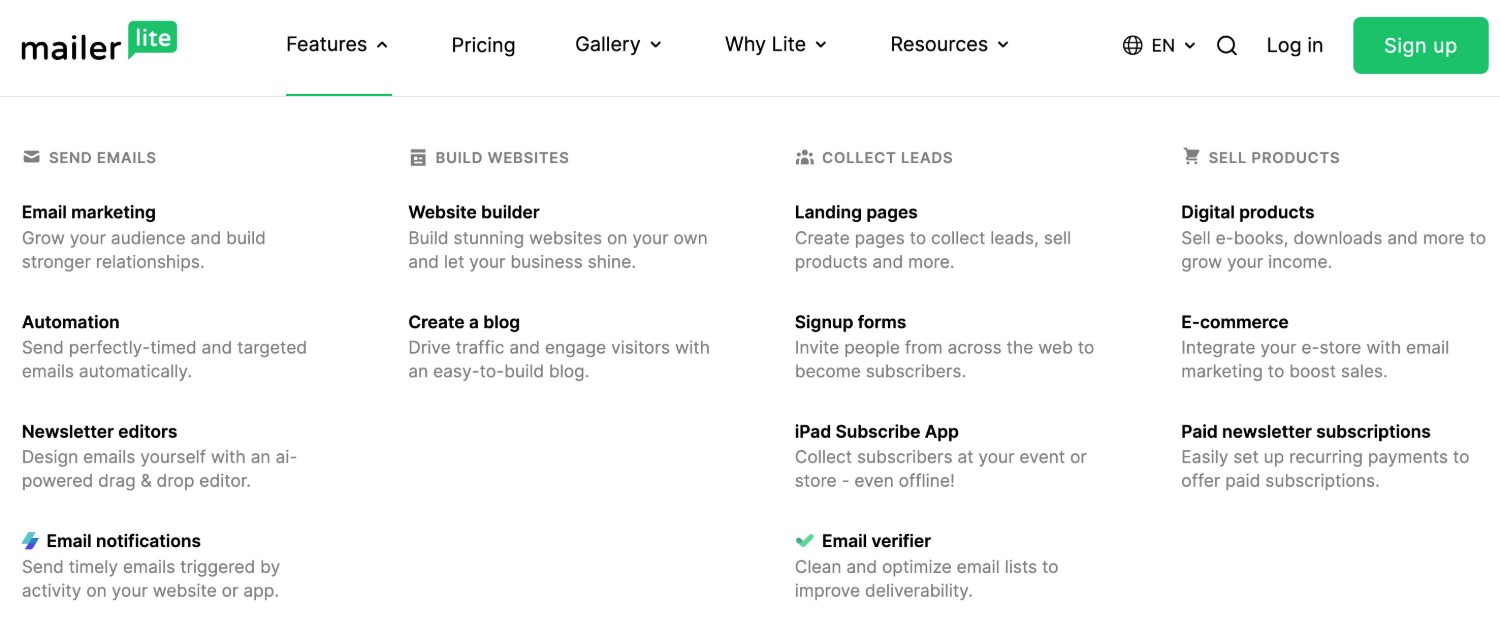
MailerLite Transactional Email
Like Mailchimp, MailerLite also offers a transactional email service called MailerSend.
While the Gravity SMTP plugin doesn’t currently offer a dedicated API integration for MailerSend like it does for Mailchimp Transactional, you can still use the Custom SMTP option in Gravity SMTP to connect to your MailerSend SMTP credentials.
Other features in MailerLite
Like Mailchimp, MailerLite also offers some other features that go beyond email:
- SMS messages – The MailerSend service also has an SMS API that lets you send all types of SMS messages. However, it’s only available in the USA and Canada currently, which is fewer countries than Mailchimp supports.
- Website builder – You can create simple websites, blogs, and/or landing pages if you don’t already have an online presence.
- Digital product sales – You can sell digital products from pages that you create with MailerLite.
- iPad subscribe app – If you have an in-person business, this lets you display an email subscribe form to customers at your store.
- Facebook custom audiences – You can create custom audiences similar to your email subscribers, which helps you run more effective ads on Facebook.
Integrations in MailerLite
MailerLite offers 160+ integrations that you can use to connect to a variety of tools, including CRMs, ecommerce platforms, and more. You can browse all of these integrations in the public directory here.

As with Mailchimp, Gravity Forms also offers its own dedicated MailerLite Add-On that lets you connect WordPress to MailerLite.
Email and automation builders
Both Mailchimp and MailerLite offer a visual, drag-and-drop email builder with lots of pre-made templates, along with the ability to directly use your own HTML templates (if you prefer that approach).
Both also offer visual automation builders that let you set up simple or complex automation sequences.
In this section, we’ll share some screenshots of those interfaces so that you can get a feel for what it’s like to use each tool.
Mailchimp
Mailchimp offers a visual, drag-and-drop email builder, though you can also add your own HTML directly if you’d prefer to code your own templates from scratch.
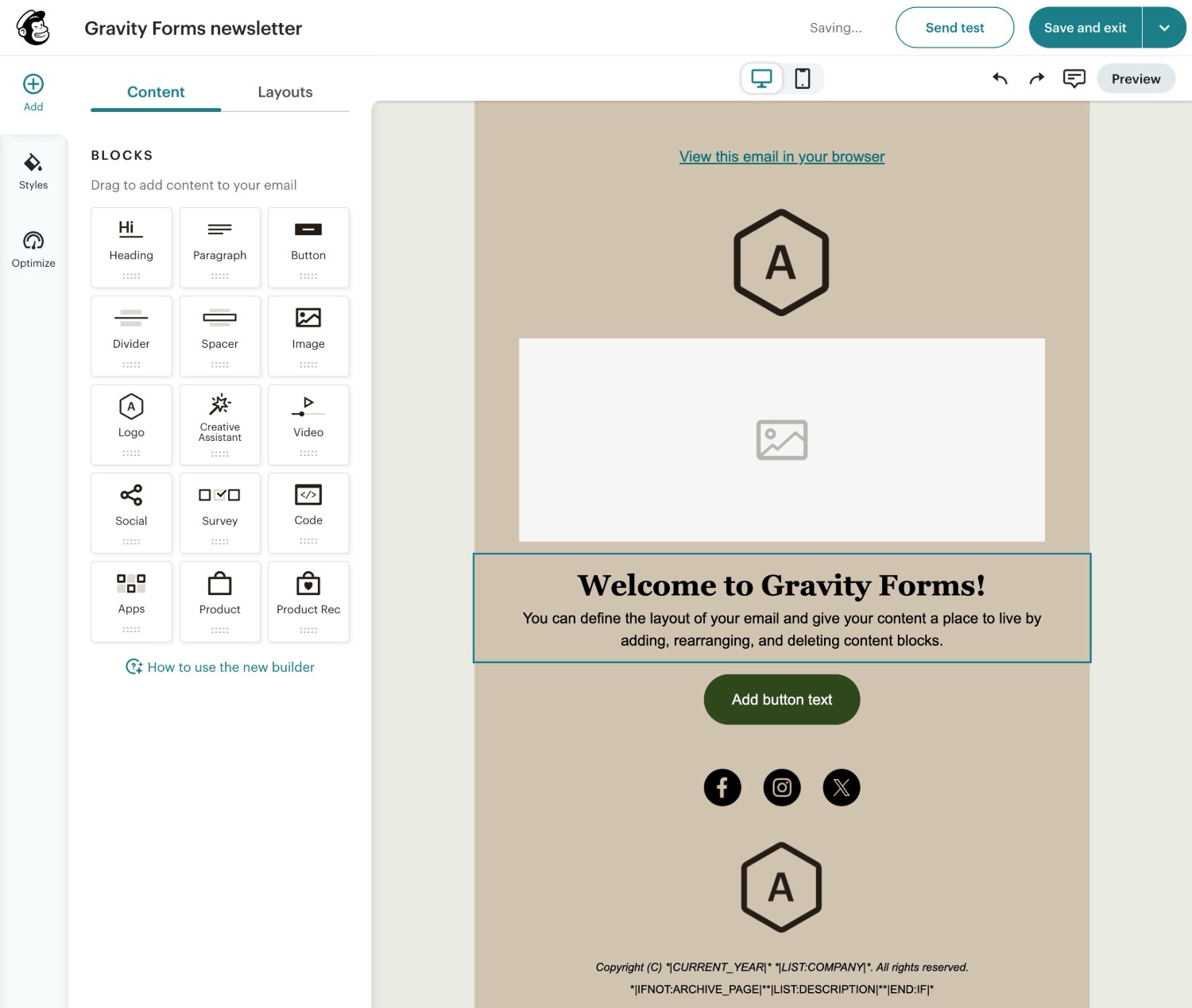
You can also create all kinds of automations using a visual builder:

MailerLite
MailerLite lets you choose from three different email editors:
- Visual, drag-and-drop editor
- Rich-text editor
- Custom HTML editor
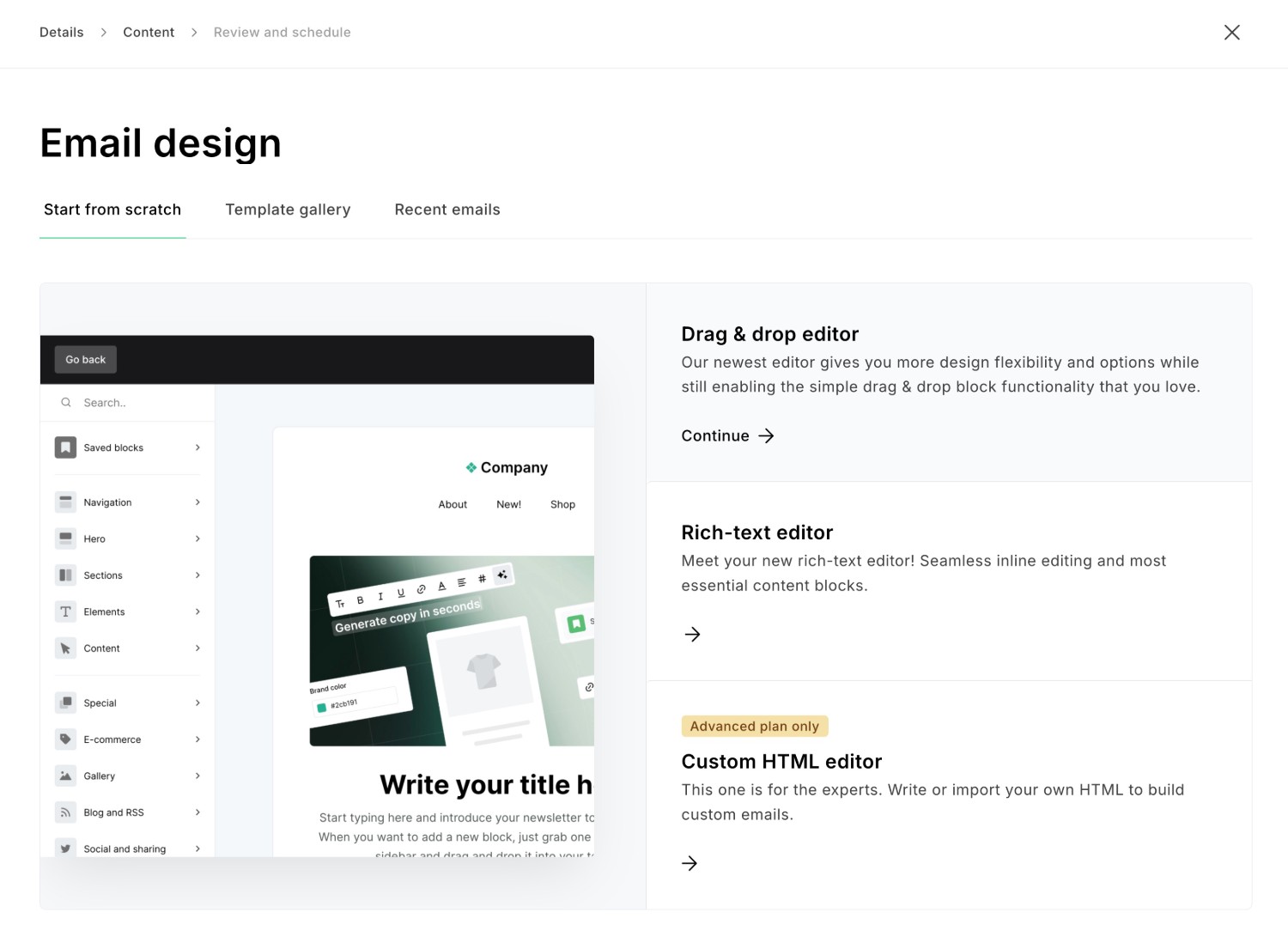
Here’s what the visual, drag-and-drop editor looks like:
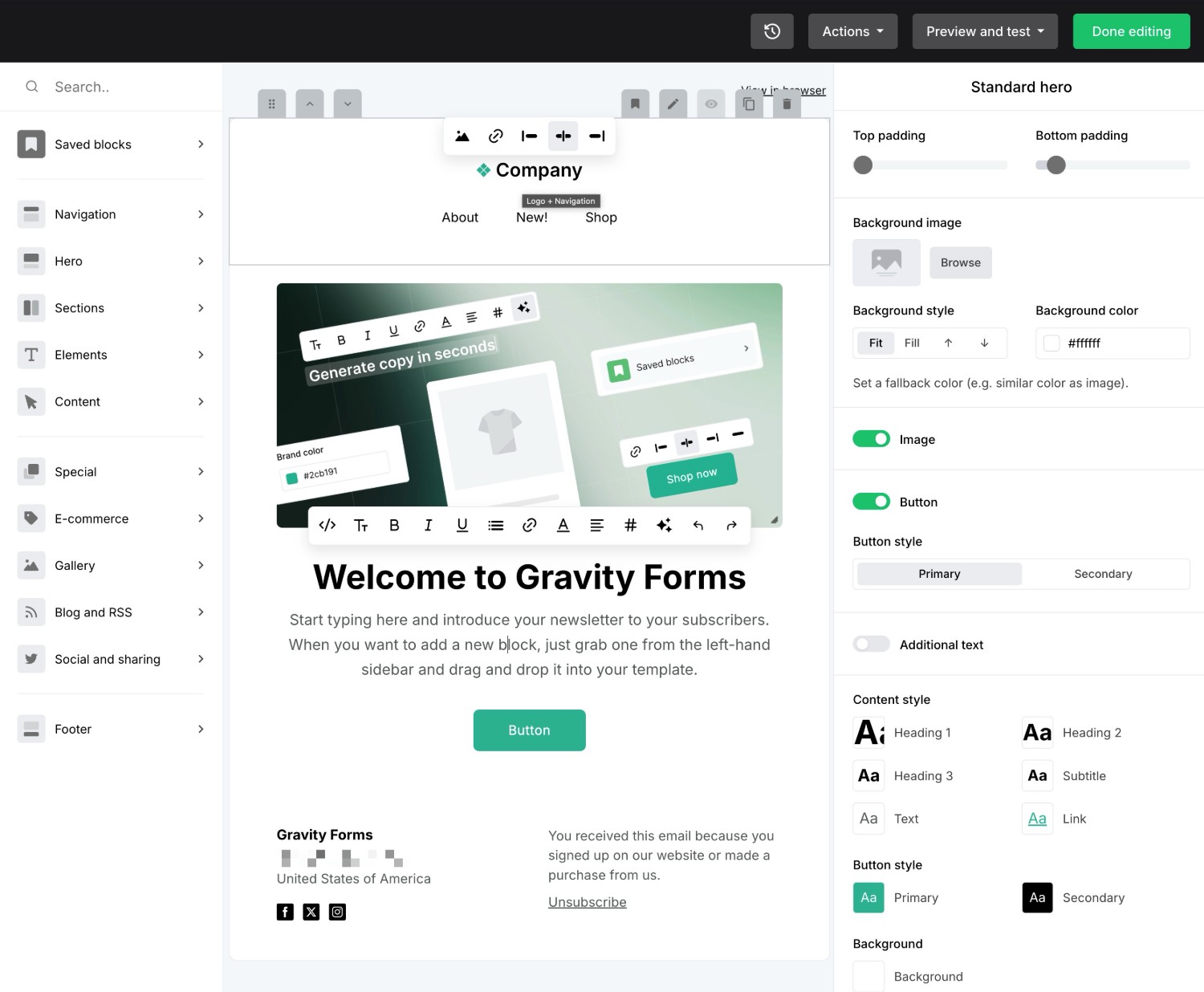
You can also set up automations using a visual builder:
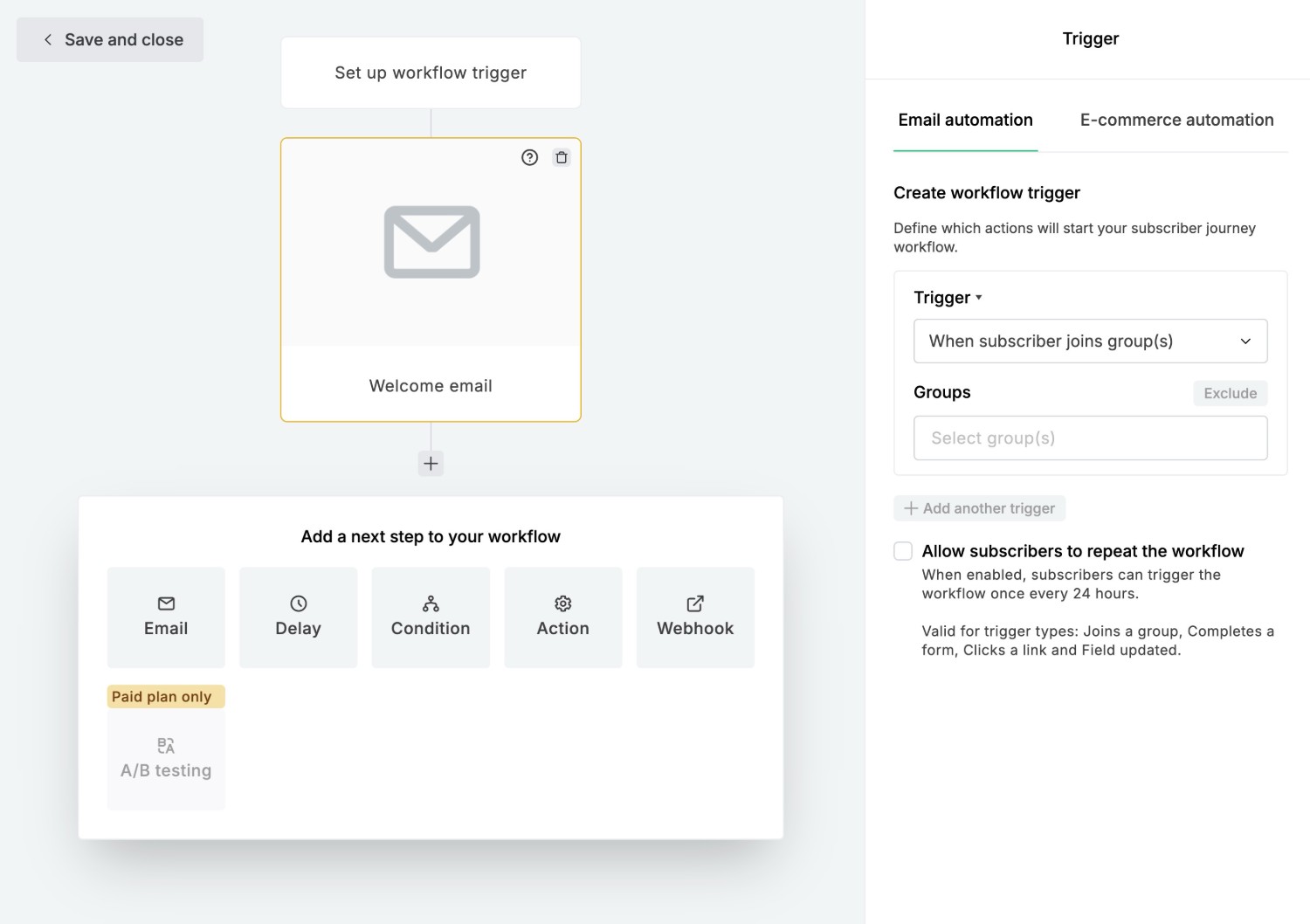
Pricing
Next, let’s talk about the pricing between these two services, as that will play an important role in most people’s choices. The details below are correct at the time of this writing, but you’ll want to double check for yourself in case anything has changed.
In general, MailerLite is usually a bit less expensive, especially if you send a high volume of emails to your contacts.
However, there are some variables to consider, so it’s important to do the math for your unique situation including the…
- Features that you need access to
- Number of contacts that you have
- Number of emails you want to send to each contact per month
To start, both Mailchimp and MailerLite use the number of contacts/subscribers you have as the primary billing metric. That is, as your number of contacts increases, the price of your plan increases.
In addition to that, both have multiple plan tiers, which gives you access to a different set of features:
- Mailchimp has three premium plan tiers and one free tier.
- MailerLite has two premium plan tiers and one free tier.
Email sending limits
One big difference between Mailchimp vs MailerLite is in your monthly email send limit. That is, the total number of emails you can send per month for your plan.
With Mailchimp, your monthly email sending limit is a multiple of the number of contacts on your plan. This multiple depends on the plan but it ranges from 10X to 15X.
For example, if you’re on the Standard plan (12X multiple) and your plan supports 2,000 contacts, your monthly email send limit will be 24,000 emails (2,000 * 12).
MailerLite, on the other hand, offers unlimited email sending on both of its paid plans. The free plan has a 12,000 email per month limit.
If you’re a very high-volume email sender, that could make MailerLite more attractive. However, if you’re only sending an email every few days, Mailchimp’s limits are usually fine, too.
Free plans
Both Mailchimp and MailerLite offer free plans, which is great because you can get started without needing to enter a credit card and you’ll only need to pay when you outgrow the free plan.
Mailchimp’s free plan has the following limits:
- 500 contacts.
- 1,000 email sends per month.
- Mailchimp branding.
MailerLite’s free plan has the following limits:
- 1,000 contacts.
- 12,000 email sends per month.
- MailerLite branding.
Premium plans
As we mentioned above, both Mailchimp and MailerLite offer multiple premium tiers.
Each premium tier comes with a different set of features to start. The price of each tier also goes up based on the number of contacts that you have.
We’ll go through some pricing comparisons for different numbers of contacts below, but let’s first look at the starting prices and core features of each plan.
Mailchimp pricing plans:
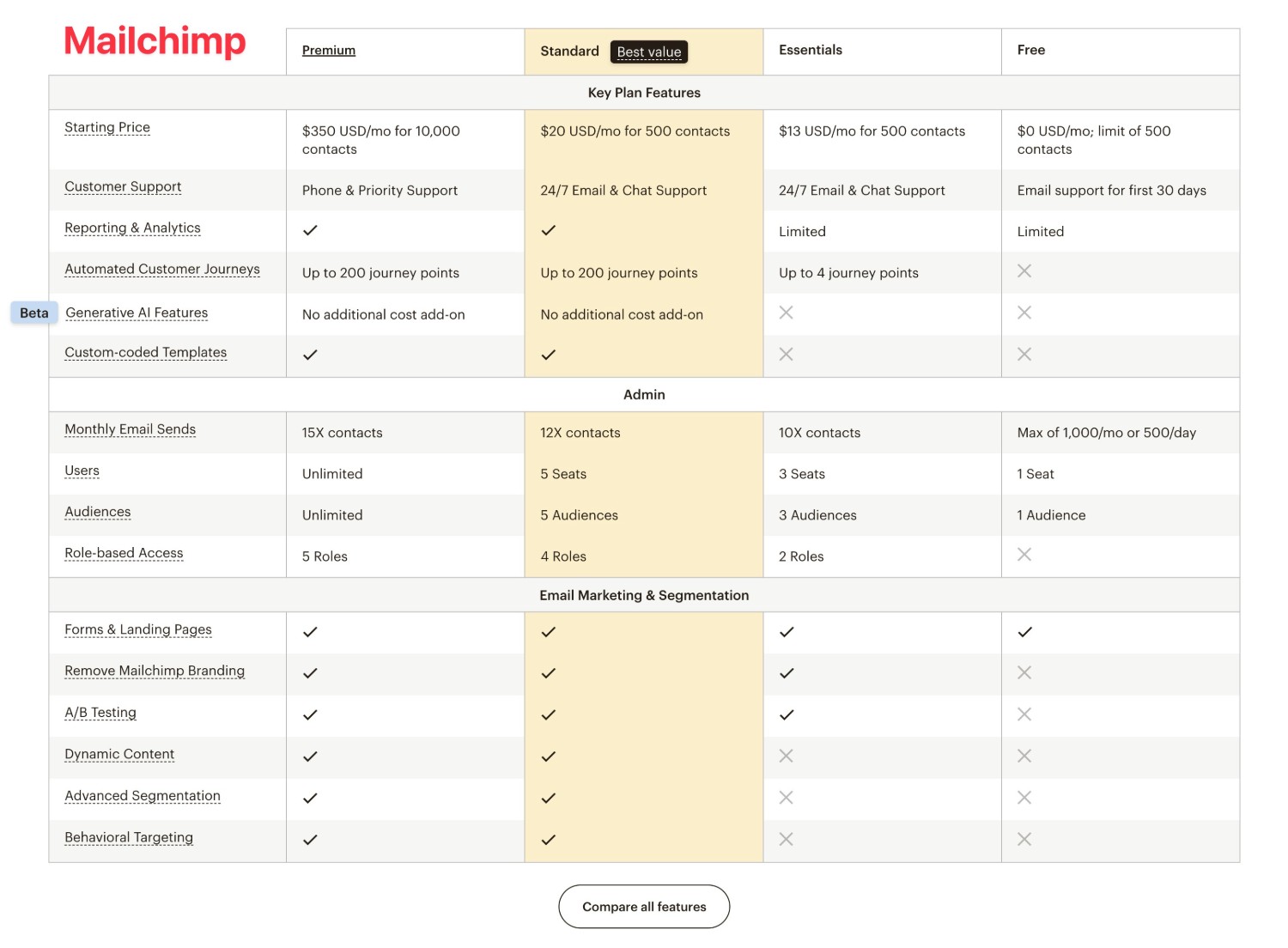
Click here to view the full Mailchimp feature comparison table.
MailerLite pricing plans:
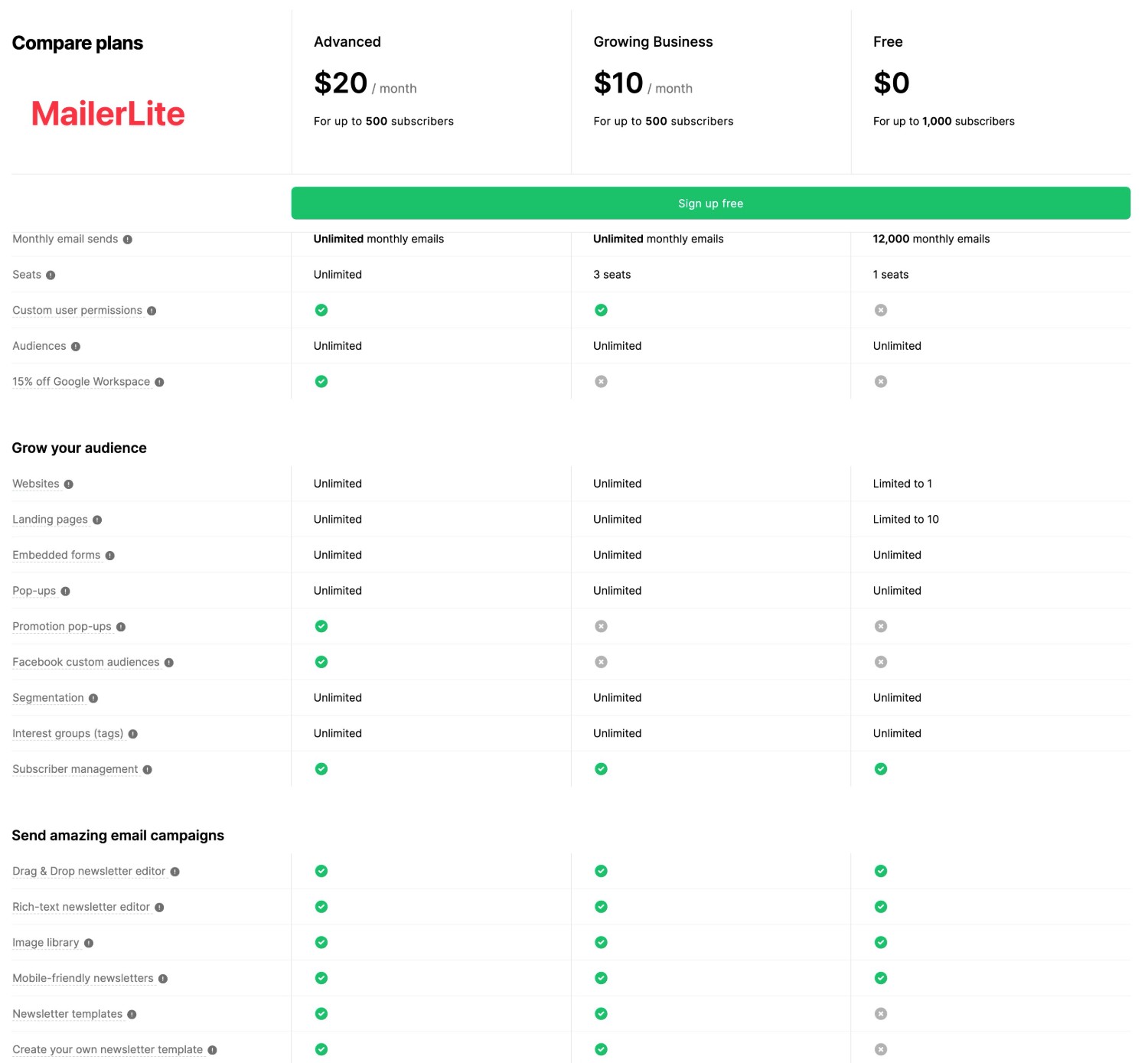
Click here to view the full MailerLite feature comparison table.
Pricing per contact
Now, let’s look at some pricing comparison tables to give you an idea of what you might pay for different numbers of contacts.
Here are the monthly prices for different numbers of contacts on each service’s entry-level plan – the Essentials plan for Mailchimp and the Growing Business plan for MailerLite.
| Mailchimp | MailerLite | |
| Monthly email send multiplier | 10X contacts | Unlimited |
| 500 contacts | $13 | $10 |
| 1,000 contacts | $26.50 | $15 |
| 1,500 contacts | $26.50 | $25 |
| 2,500 contacts | $45 | $25 |
| 5,000 contacts | $75 | $39 |
| 10,000 contacts | $110 | $73 |
| 20,000 contacts | $230 | $139 |
| 50,000 contacts | $385 | $289 |
For another point of comparison, here are the prices for the second-tier plans – the Standard plan at Mailchimp and the Advanced plan at MailerLite.
| Mailchimp | MailerLite | |
| Monthly email send multiplier | 12X contacts | Unlimited |
| 500 contacts | $20 | $20 |
| 1,000 contacts | $45 | $30 |
| 1,500 contacts | $45 | $40 |
| 2,500 contacts | $60 | $40 |
| 5,000 contacts | $100 | $50 |
| 10,000 contacts | $135 | $110 |
| 20,000 contacts | $285 | $180 |
| 50,000 contacts | $450 | $340 |
In general, MailerLite is the more affordable option when you purely look at contact limits and monthly email sends. However, you’ll also want to compare the specific features that you get access to on each plan, as your unique use case could still make Mailchimp a better value.
Overage pricing
All of Mailchimp’s plans come with a monthly email sending limit that’s a multiple of the number of contacts supported by your plan.
However, you might have situations when you need to send more emails than your plan allows. Mailchimp allows this, but you will need to pay a bit extra by purchasing add-on blocks.
Because MailerLite allows unlimited email sending on its paid plans, there are no overage fees for email sending.
Transactional email pricing
As we mentioned earlier, both Mailchimp and MailerLite also offer transactional email sending plans.
Mailchimp Transactional is an add-on to your existing Mailchimp plan. Instead of a fixed monthly price, you can purchase credit blocks based on your actual usage.
Each block lets you send 25,000 emails. The price of a block goes down as you purchase higher quantities.
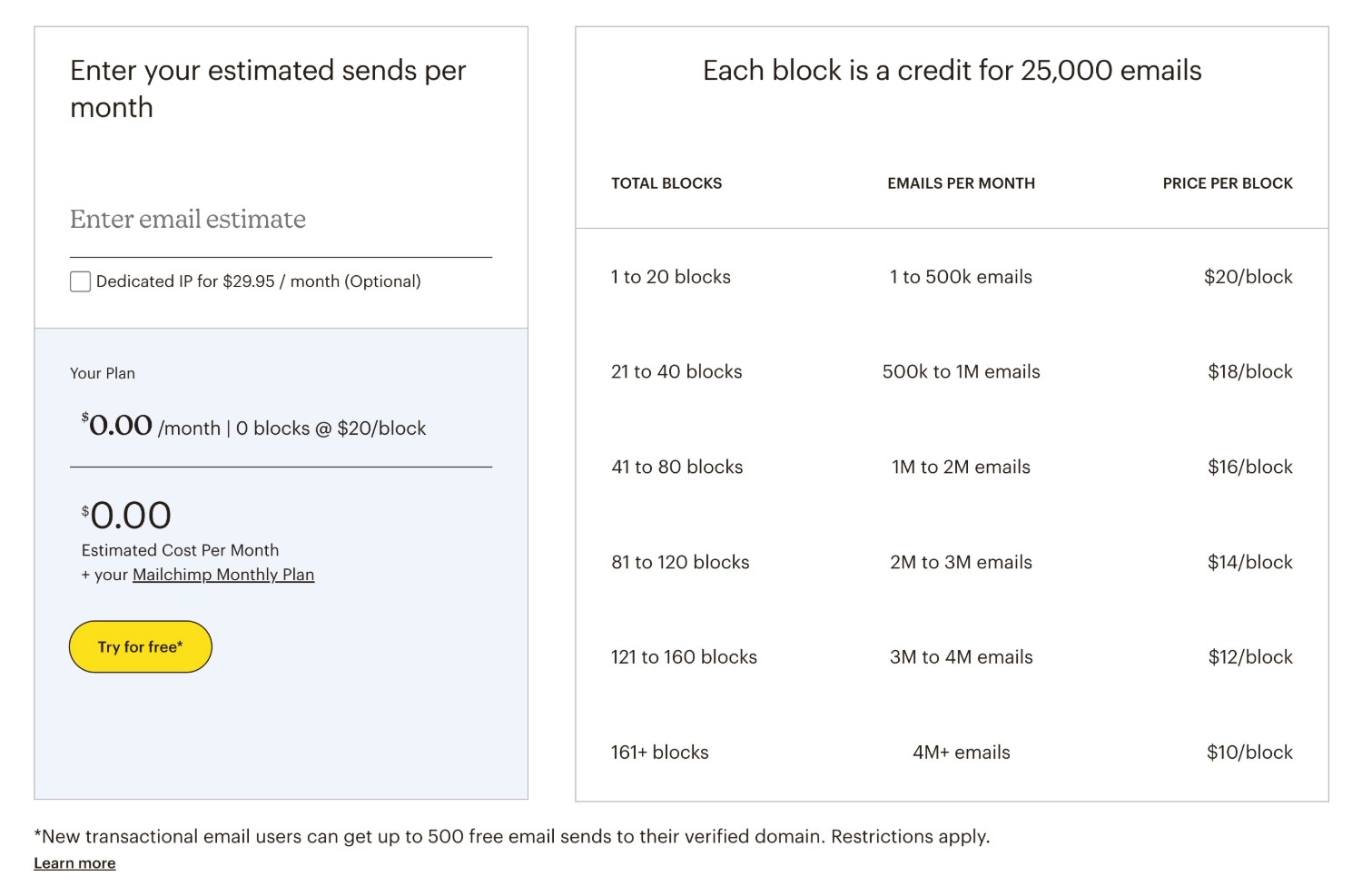
MailerSend (MailerLite’s transactional email service) has a free plan that lets you send 3,000 emails per month ($1 per additional 1,000 emails). Or, there are also fixed monthly plans starting at $35 for 50,000 emails.
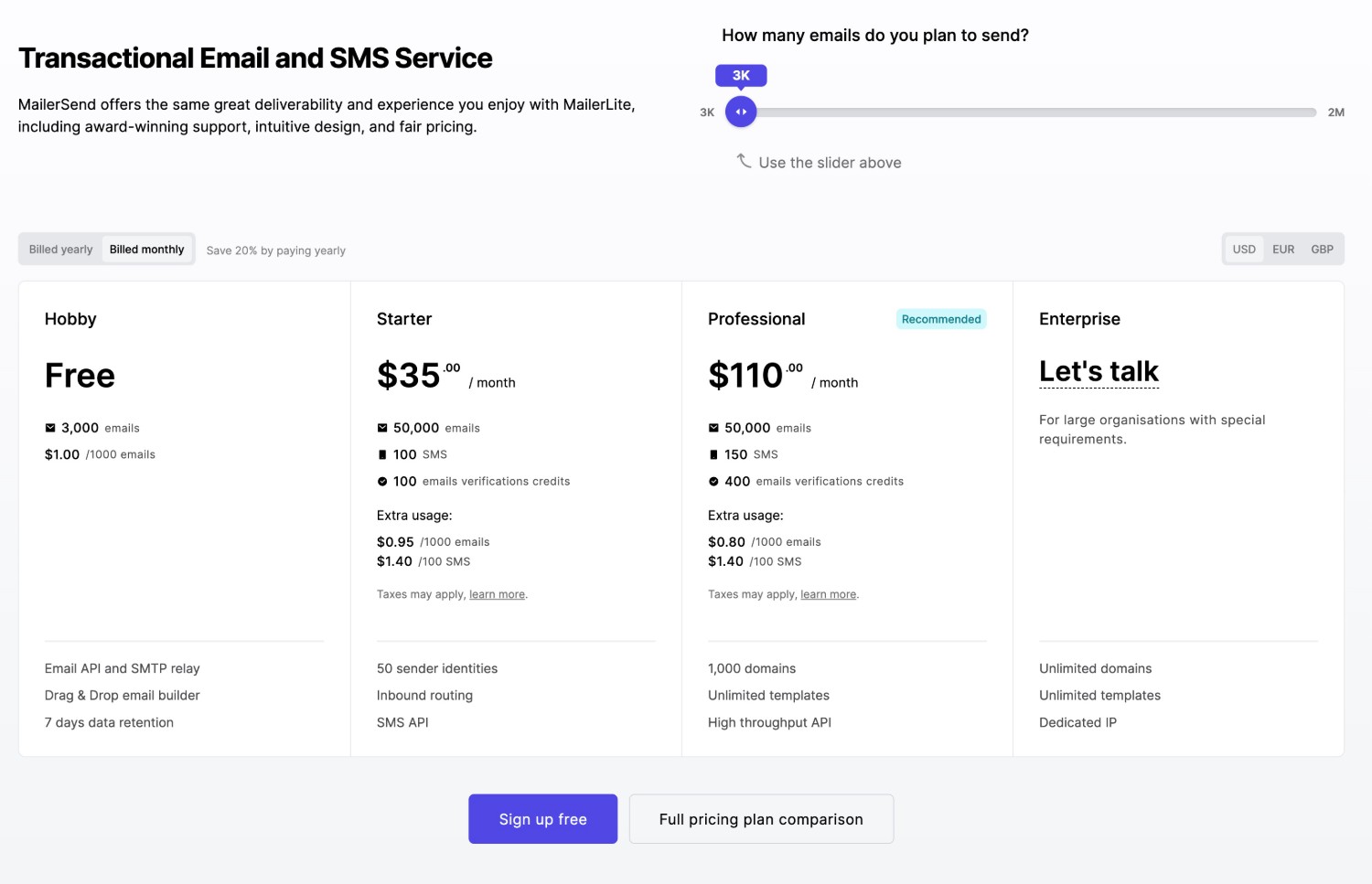
Gravity Forms Add-Ons: Mailchimp vs MailerLite
If you’re using WordPress for your website, you can use the Gravity Forms plugin to easily integrate both Mailchimp and MailerLite into your site.
To give you more flexibility, Gravity Forms has its own add-ons for both Mailchimp and MailerLite. These add-ons allow you to sync subscribers to your email lists after they submit a form on your site.
You can use them to create dedicated email subscribe forms. Or, you can add email subscribe functionality to a different type of form on your site, such as giving people an option to subscribe after they make a payment or register for your website.
Gravity Forms Mailchimp Add-On
Here are some of the main features of the Gravity Forms Mailchimp Add-On:
- Sync form submissions to Mailchimp audiences – Add a person to your Mailchimp audience(s) when they submit any form on your site
- Apply tags and notes in Mailchimp – Add tags and notes to contacts in Mailchimp, which allows for easy segmentation. You can also use merge tags to dynamically include information in your tags or notes.
- Map form fields to Mailchimp – Map the fields in your form to fields in Mailchimp, including support for any custom fields that you’ve added to your Mailchimp account.
- Enable Double opt-in – When enabled, this will only add people to your Mailchimp audience if they click the link in a confirmation email that they receive after submitting the form.
- Use conditional logic – Use conditional logic to control when to add people to your Mailchimp audience(s). For example, you could only add a person if they check a box to explicitly opt-in to your newsletter.
To see it in action, check out our guide on how to use Mailchimp with Gravity Forms. We also have an entire guide to using Mailchimp with WordPress.
Gravity Forms MailerLite Add-On
Here are some of the key features of the Gravity Forms MailerLite Add-On:
- Sync form submissions to MailerLite groups – Add a person to any of your MailerLite groups after they submit the form.
- Map form fields to MailerLite – Map the fields in your form to the core fields in MailerLite, along with any custom fields that you’ve added to MailerLite.
- Use conditional logic – Use conditional logic to only add a person to your MailerLite groups if certain conditions are met, such as explicitly checking a box to join your newsletter.
To see it in action, check out our guide on how to use MailerLite with Gravity Forms.
Final thoughts
In the end, both Mailchimp and MailerLite can work great for email marketing, which is why they’ve both achieved so much success in the market.
There’s no single “winner” and your choice should really come down to your specific use case and budget.
If you’re still on the fence, both Mailchimp and MailerLite offer free plans, along with free trials to test all of the premium functionality. So – feel free to sign up to both services and test them out to find which one works better.
Regardless of whether you choose Mailchimp or MailerLite, you’ll be able to use either service with the Gravity Forms plugin via official add-ons that come directly from the Gravity Forms team.
You can access both add-ons on every single Gravity Forms license. If you don’t have a Gravity Forms license yet, purchase your license today to get started with Mailchimp or MailerLite on WordPress.

If you want to keep up-to-date with what’s happening on the blog sign up for the Gravity Forms newsletter!

